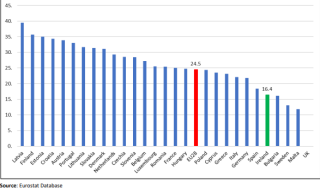Towards Wellbeing For All - Subjective Wellbeing

The Programme for Government acknowledged that our “existing measures of economic performance fail to measure matters such as damage to the environment and voluntary work. They also overlook equality of opportunity, distribution of wealth and income and only value public expenditure on the basis of the inputs used, not the outcomes achieved” and committed to introducing a series of indicators that would more accurately measure wellbeing to provide a “holistic view of how our society is faring”.
A ‘Wellbeing Dashboard’ was then developed to provide a snapshot of progress. In developing the Dashboard, the Inter-Departmental Working Group established a list of 35 indicators chosen to be balanced, add value or be of policy relevance, provide for aggregation and dis-aggregation, be readily available and of sufficient quality, and be internationally comparable.
So how are we doing? To gauge public opinion on what matters, and what should therefore be counted as an indicator of Well-being, Social Justice Ireland produced a survey asking people to rank a set of six indicators under each of the Well-being Framework dimensions from one to six, with one being the least important and six being the most important. The six indicators included the indicators used in the Dashboard and datasets readily available from the CSO and other reputable sources. This survey was circulated over the Summer months through our social media channels, our Weekly Digest, and our Members Bulletin. What follows is based on the responses to this survey and our policy proposals under each of the 11 dimensions.
Subjective wellbeing is measured using data relating to the proportion of the population rating their overall life satisfaction. The indicators with the highest weighted ranking under this dimension were Overall life satisfaction; Social Inclusion; and Access to Public Services.
Overall, Ireland, with a rate of 44.4 per cent in 2018, increasing from 30.8 per cent in 2013 and comparing well to the EU average, appears to be doing well. Data from the CSO is further broken down by age group and self-perceived health status. Using health status as a proxy for marginalisation, we look at the gap between the proportion of those who reported their health as ‘Very Good’ and those who reported it as ‘Fair/Bad/Very Bad’ with an overall life satisfaction rating of ‘High’. Between 2013 and 2018, the gap increased from 19.7pps to 34.7pps (Chart 1). Those with poorer health are falling further behind.
Chart 1: % Population who rate life satisfaction as ‘High’ by self-perceived health status, 2013 to 2018

At a European level, the data may be disaggregated by educational attainment level. Using lowest and highest educational attainment as a proxy (there is a strong correlation between educational attainment and reduced poverty risk), Ireland compares well, having the highest rate of life satisfaction among the population with the lowest educational attainment, and the sixth lowest gap between lowest and highest educational attainment.
On social inclusion, Ireland scores 7.5 out of 10. At a European level, Ireland compares well for the proportion of the population with some or severe self-perceived long-standing limitations in usual activities due to health problems at 16.4 per cent in 2019, the fourth lowest across the EU 28, down from 17.6 per cent in 2014 (Chart 2).
Chart 2: % Population with some or severe self-perceived long-standing limitations in usual activities due to health problems

Finally, under this dimension, we turn to access to public services. This data is based on the CSO Trust Survey [1] which includes a rating of satisfaction with public services. The proportion of the population who are satisfied with the Administrative Services and Education System are quite high (at 63 and 70 per cent respectively), while just 32 per cent were satisfied with the Health System. Policy Priorities If Government wishes to improve the Subjective Wellbeing of people living in Ireland, it must: • Support policies that enhance the standard of living of people who are most marginalised, including people with disabilities. • Specifically, address poverty among people with disabilities, starting with the introduction of a cost of disability payment. • Work to eliminate the barriers faced by people with disabilities in accessing basic services such as housing, healthcare, and education. • Increase educational campaigns promoting health, targeting particularly people who are poor, acknowledging that a preventative approach saves money in the long run. • Properly resource and develop mental health services and facilitate campaigns giving greater attention to the issue of suicide.
[1] https://www.cso.ie/en/csolatestnews/presspages/2022/trustsurveydecember…
Policy Priorities
- If Government wishes to improve the Subjective Wellbeing of people living in Ireland, it must:
- Support policies that enhance the standard of living of people who are most marginalised, including people with disabilities.
- Specifically, address poverty among people with disabilities, starting with the introduction of a cost of disability payment.
- Work to eliminate the barriers faced by people with disabilities in accessing basic services such as housing, healthcare, and education.
- Increase educational campaigns promoting health, targeting particularly people who are poor, acknowledging that a preventative approach saves money in the long run.
- Properly resource and develop mental health services and facilitate campaigns giving greater attention to the issue of suicide.